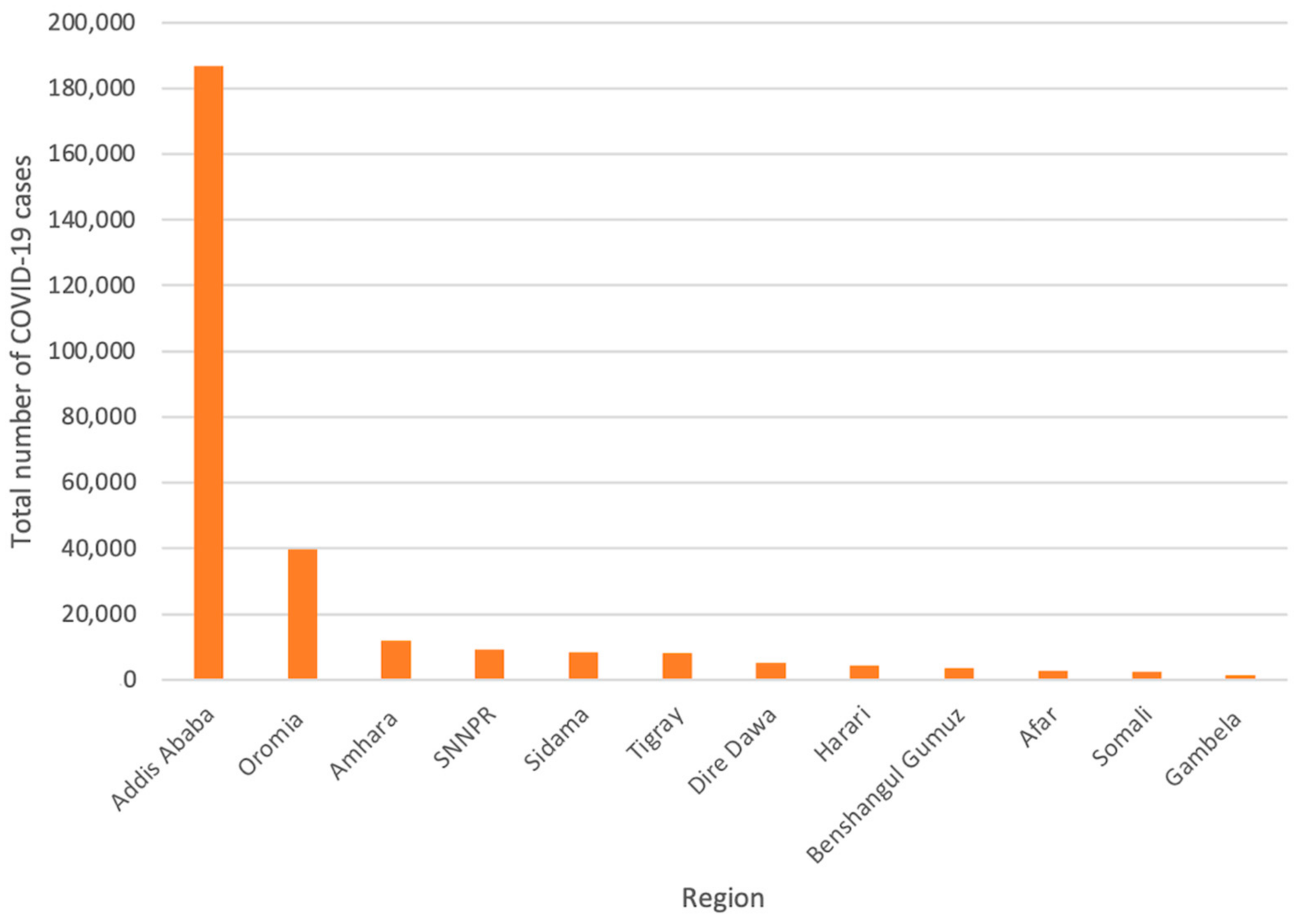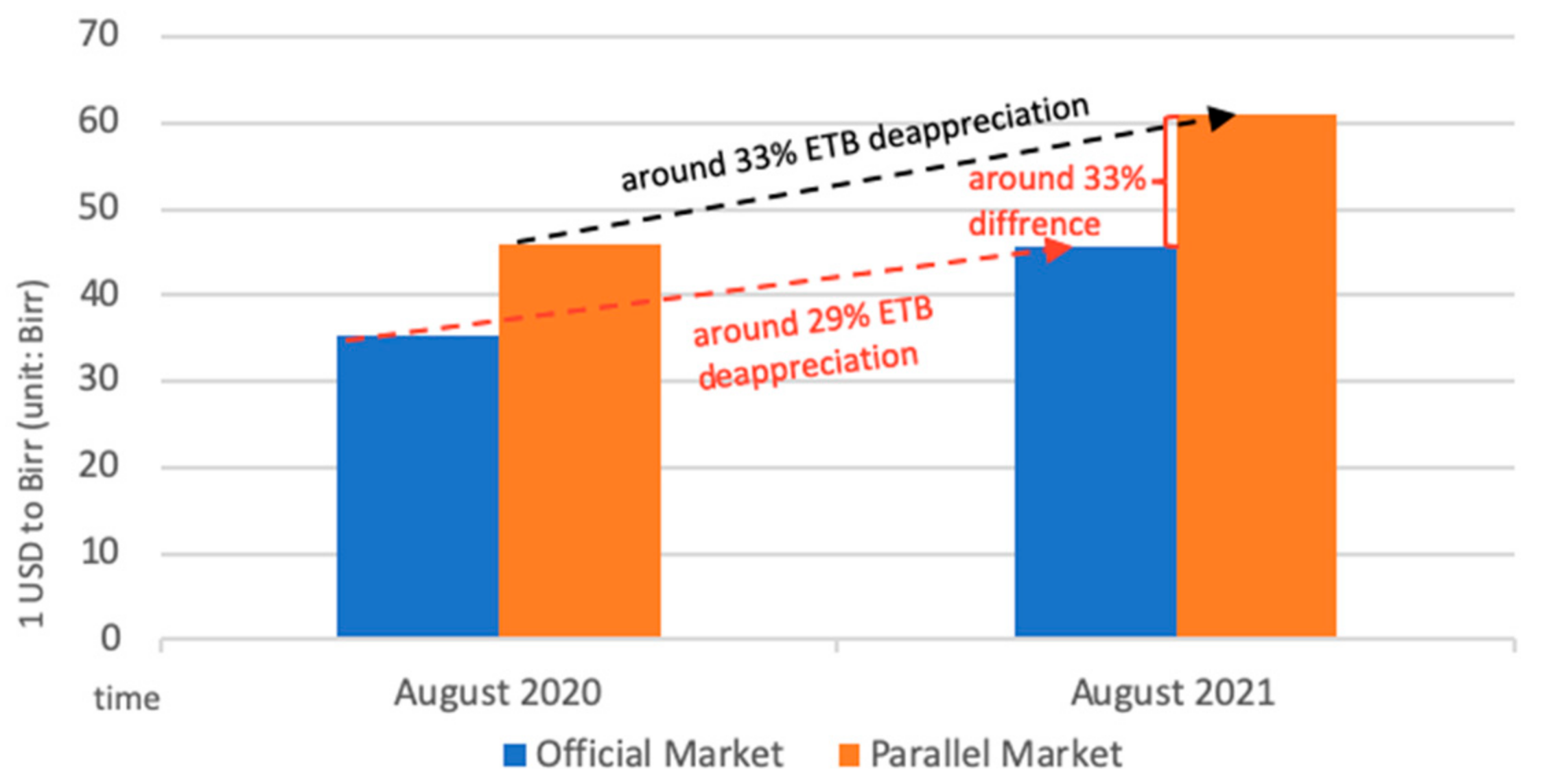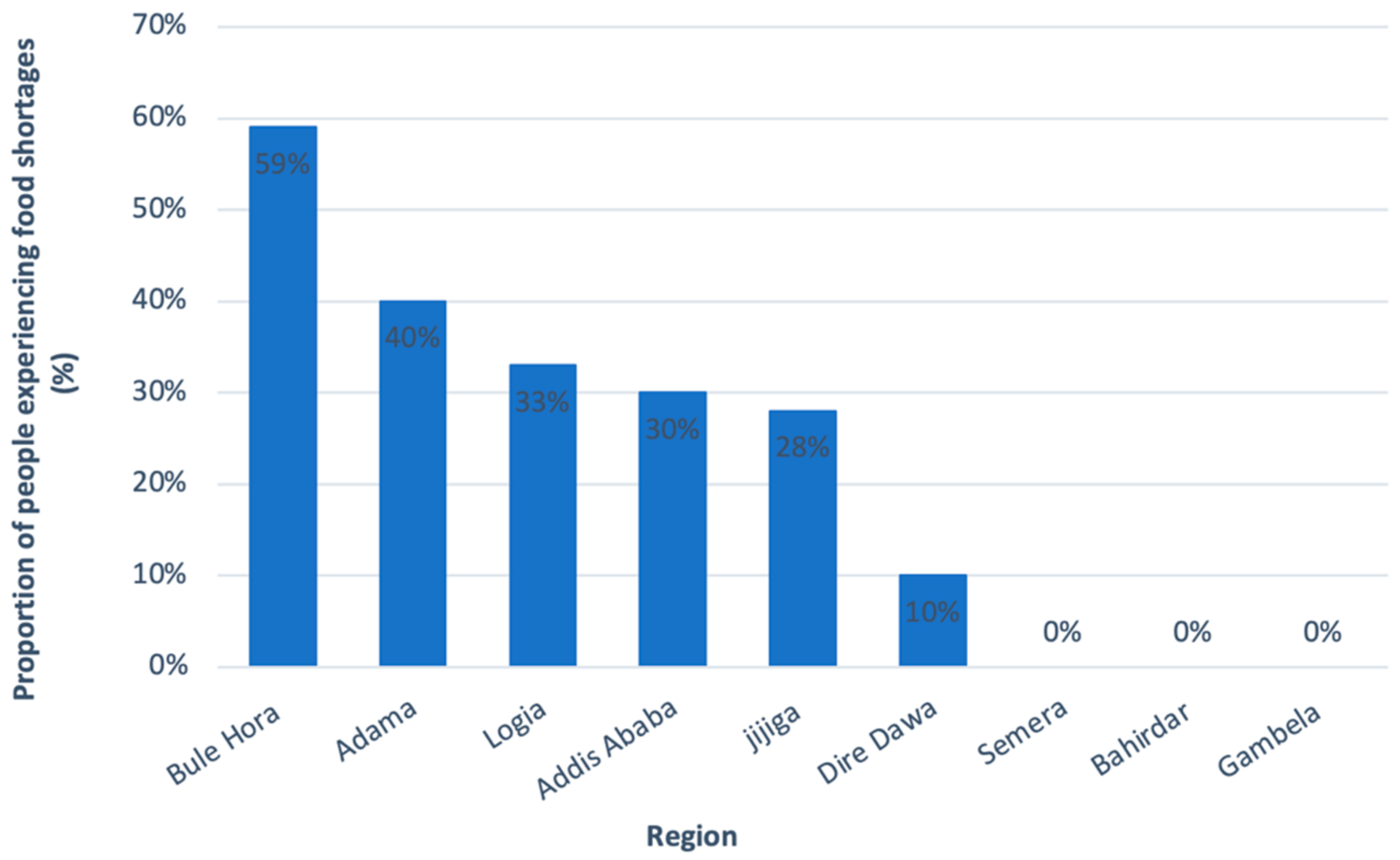Impact of COVID-19 on Food Security in Ethiopia
Abstract
:1. Introduction
2. Materials and Methods
3. Case Presentation
3.1. Agro-Pastoral System, Economic, Political and Geographical Situation
3.2. Healthcare System
3.3. COVID-19 Related Epidemiological Situation and Non-Pharmaceutical Intervention
3.4. Non-Pharmaceutical Interventions
4. Impact of COVID-19 on Food Security in ETHIOPIA
4.1. COVID-19 Impact on Food Value Chain
4.2. Ongoing and Disrupted Food-Related Social Security Programmes
4.3. Differentiated Impacts on Affected Groups/Areas
4.3.1. Urban Areas
4.3.2. Rural Areas
4.3.3. IDPs and Refugees
4.3.4. Conflict Located Areas
5. Discussion
Author Contributions
Funding
Data Availability Statement
Conflicts of Interest
References
- United Nations. Policy Brief: The Impact of COVID-19 on Food Security and Nutrition; Food and Agriculture Organisation of the United Nations: Rome, Italy, 2020; 23p, Available online: https://www.un.org/sites/un2.un.org/files/sg_policy_brief_on_covid_impact_on_food_security.pdf (accessed on 16 November 2021).
- Workie, E.; Mackolil, J.; Nyika, J.; Ramadas, S. Deciphering the impact of COVID-19 pandemic on food security, agriculture, and livelihoods: A review of the evidence from developing countries. Curr. Res. Environ. Sustain. 2020, 2, 100014. [Google Scholar] [CrossRef]
- WHO. Constitution of the World Health Organisation; WHO: Geneva, Switzerland, 2021; Available online: https://www.who.int/about/governance/constitution (accessed on 7 December 2021).
- Mohamed, A.A. Food Security Situation in Ethiopia: A Review Study. Int. J. Health Econ. Policy 2017, 2, 86. [Google Scholar]
- Swinnen, J.; McDermott, J. Covid-19 and Global Food Security. EuroChoices. 2020, 19, 26–33. [Google Scholar] [CrossRef]
- Laborde, D.; Martin, W.; Vos, R. Poverty and Food Insecurity Could Grow Dramatically as COVID-19 Spreads. 2020. Available online: https://www.ifpri.org/blog/poverty-and-food-insecurity-could-grow-dramatically-covid-19-spreads (accessed on 30 October 2021).
- Laborde, D.; Martin, W.; Vos, R. Impacts of COVID-19 on Global Poverty, Food Security and Diets; International Food Policy Research Institute: Washington, DC, USA, 2020; 50p, Available online: https://www.foodsecurityportal.org/sites/default/files/2021-01/Laborde-Martin-Vos%20Impacts%20of%20COVID-19%20on%20Global%20Poverty%20etc%20IFPRI%20DP1993.pdf (accessed on 30 October 2021).
- Glauber, J.; Laborde, D.; Martin, W.; Vos, R. COVID-19: Trade Restrictions are Worst Possible Response to Safeguard Food Security. 2020. Available online: https://www.ifpri.org/blog/covid-19-trade-restrictions-are-worst-possible-response-safeguard-food-security (accessed on 31 October 2021).
- O’Hara, S.; Toussaint, E.C. Food access in crisis: Food security and COVID-19. Ecol. Econ. 2021, 180, 106859. [Google Scholar] [CrossRef]
- Funk, C.; Rowland, J.; Eilerts, G.; Kebebe, E.; Biru, N.; White, L.; Galu, G. A Climate Trend Analysis of Ethiopia. 2012. Available online: http://pubs.er.usgs.gov/publication/fs20123053 (accessed on 17 November 2021).
- Chamberlin, J.; Schmidt, E. Ethiopian Agriculture: A Dynamic Geographic Perspective; International Food Policy Research Institute: Washington, DC, USA, 2011; 29p, Available online: https://reliefweb.int/sites/reliefweb.int/files/resources/D2F97DBDAC3C28CB8525784D00639E2C-Full_Report.pdf (accessed on 7 December 2021).
- Amede, T.; Auricht, C.; Boffa, J.M.; Dixon, J.; Mallawaarachchi, T.; Rukuni, M.; Teklewold-Deneke, T. A Farming System Framework for Investment Planning and Priority Setting in Ethiopia; ACIAR: Bruce, Australia, 2017; 51p, Available online: https://www.researchgate.net/publication/318012051_A_farming_system_framework_for_investment_planning_and_priority_setting_in_Ethiopia (accessed on 17 November 2021).
- Kassaye, A.Y.; Shao, G.; Wang, X.; Shifaw, E.; Wu, S. Impact of climate change on the staple food crops yield in Ethiopia: Implications for food security. Theor. Appl. Climatol. 2021, 145, 327–343. [Google Scholar] [CrossRef]
- Lewis, K. Understanding climate as a driver of food insecurity in Ethiopia. Clim. Change 2017, 144, 317–328. [Google Scholar] [CrossRef] [Green Version]
- Alemu, T.; Mengistu, A. Impacts of Climate Change on Food Security in Ethiopia: Adaptation and Mitigation Options: A Review. In Climate Change-Resilient Agriculture and Agroforestry; Climate Change Management; Springer: Cham, Switzerland, 2019; pp. 397–412. Available online: https://link.springer.com/chapter/10.1007%2F978-3-319-75004-0_23#citeas (accessed on 14 November 2021).
- Salih, A.A.M.; Baraibar, M.; Mwangi, K.K.; Artan, G. Climate change and locust outbreak in East Africa. Nat. Clim. Change 2020, 10, 584–585. [Google Scholar] [CrossRef]
- FAO Ethiopia. Ethiopia: Desert Locusts Drive One Million to Food Insecurity. 2020. Available online: https://www.fao.org/ethiopia/news/detail-events/en/c/1270924/ (accessed on 15 November 2021).
- Yigzaw, G.S.; Abitew, E.B. Causes and impacts of internal displacement in Ethiopia. Afr. J. Soc. Work. 2020, 9, 32–41. [Google Scholar]
- Human Rights Watch. Ethiopia: Events of 2020. 2020. Available online: https://www.hrw.org/world-report/2021/country-chapters/ethiopia (accessed on 17 November 2021).
- The Food Security Information Network. Global Report on Food Crises; FSIN: Rome, Italy, 2021; pp. 45–55, 140–144. Available online: https://docs.wfp.org/api/documents/WFP-0000127343/download/?_ga=2.127598664.414706713.1636619949-2019868009.1636493962 (accessed on 10 November 2021).
- Gavin, M. Conflict in Ethiopia. 2021. Available online: https://cfr.org/global-conflict-tracker/conflict/conflict-ethiopia (accessed on 15 November 2021).
- Abafita, J.; Kim, K. Determinants of Household Food Security in Rural Ethiopia: An Empirical Analysis. 2014. Available online: https://ageconsearch.umn.edu/record/196613 (accessed on 13 November 2021).
- Tadesse, T.B.; Abebaw, S. A Review on Status and Determinants of Household Food Security in Ethiopia. Ethiop. J. Environ. Stud. Manag. 2019, 12, 497–508. [Google Scholar]
- Feenstra, R.C.; Inklaar, R.; Timmer, M.P. The Next Generation of the Penn World Table. Am. Econ. Rev. 2015, 105, 3150–3182. [Google Scholar] [CrossRef] [Green Version]
- The World Bank (n.d.). World Development Indicators. Available online: https://databank.worldbank.org/reports.aspx?source=world-development-indicators (accessed on 17 November 2021).
- World Bank. Ethiopia Poverty Assessment: Harnessing Continued Growth for Accelerated Poverty Reduction; World Bank: Washington, DC, USA, 2020; Available online: https://openknowledge.worldbank.org/handle/10986/33544 (accessed on 17 November 2021).
- Bersisa, M.; Heshmati, A. A Distributional Analysis of Uni-and Multidimensional Poverty and Inequalities in Ethiopia. Soc. Indic. Res. 2021, 155, 805–835. [Google Scholar] [CrossRef]
- Shibre, G.; Zegeye, B.; Idriss-Wheeler, D.; Yaya, S. Inequalities in measles immunization coverage in Ethiopia: A cross-sectional analysis of demographic and health surveys 2000–2016. BMC Infect. Dis. 2020, 20, 481. [Google Scholar] [CrossRef] [PubMed]
- Shibre, G.; Zegeye, B.; Idriss-Wheeler, D.; Yaya, S. Trends of inequalities in care seeking behavior for under-five children with suspected pneumonia in Ethiopia: Evidence from Ethiopia demographic and health surveys (2005–2016). BMC Public Health 2021, 21, 258. [Google Scholar] [CrossRef]
- Assefa, Y.; Hill, P.S.; Gilks, C.F.; Admassu, M.; Tesfaye, D.; Van Damme, W. Primary health care contributions to universal health coverage, Ethiopia. Bull. World Health Organ. 2020, 98, 894–905A. [Google Scholar] [CrossRef] [PubMed]
- Banteyerga, H. Ethiopia’s Health Extension Program: Improving Health through Community Involvement. MEDICC Rev. 2011, 13, 46. [Google Scholar] [CrossRef] [PubMed]
- Assefa, Y.; Gelaw, Y.A.; Hill, P.S.; Taye, B.W.; Van Damme, W. Community health extension program of Ethiopia, 2003–2018: Successes and challenges toward universal coverage for primary healthcare services. Glob. Health 2019, 15, 24. [Google Scholar] [CrossRef] [PubMed] [Green Version]
- Wang, H.; Tesfaye, R.; Ramana, G.N.V.; Chekagn, C.T. Ethiopia Health Extension Program an Institutionalized Community Approach for Universal Health Coverage; World Bank: Washington, DC, USA, 2016; Available online: https://openknowledge.worldbank.org/handle/10986/24119 (accessed on 17 March 2022).
- Desta, A.A.; Woldearegay, T.W.; Gebremeskel, E.; Alemayehu, M.; Getachew, T.; Gebregzabiher, G.; Ghebremedhin, K.D.; Zgita, D.N.; Aregawi, A.B.; Redae, G. Impacts of COVID-19 on essential health services in Tigray, Northern Ethiopia: A pre-post study. PLoS ONE 2021, 16, e0256330. [Google Scholar] [CrossRef]
- Ethiopianhealthdata.org. COVID-19 Case Tracker: Ethiopia and Africa. 2021. Available online: https://ethiopianhealthdata.org/ (accessed on 17 October 2021).
- Ethiopian Public Health Institute. Covid 19—Ethiopian Public Health Institute. 2021. Available online: https://ephi.gov.et/ (accessed on 17 November 2021).
- WHO. 2.2 million COVID-19 Vaccines Allocated by the COVAX Facility Arrive in Ethiopia, Marking the Start of the Country’s COVID-19 Vaccination Campaign. 2021. Available online: https://www.afro.who.int/news/22-million-covid-19-vaccines-allocated-covax-facility-arrive-ethiopia-marking-start-countrys (accessed on 17 November 2021).
- GAVI. COVAX Roll-Out—Ethiopia. 2021. Available online: https://www.gavi.org/covax-vaccine-roll-out/ethiopia (accessed on 18 October 2021).
- Hale, T.; Angrist, N.; Goldszmidt, R.; Kira, B.; Petherick, A.; Phillips, T.; Webster, S.; Cameron-Blake, E.; Hallas, L.; Majumdar, S.; et al. Oxford COVID-19 Government Response Tracker, Blavatnik School of Government. Data use policy: Creative Commons Attribution CC BY standard. 2020. Available online: https://covidtracker.bsg.ox.ac.uk/ (accessed on 7 December 2021).
- GardaWorld. Ethiopia: Regional Authorities Ban Public Transportation as of March 30/Update 6. 2020. Available online: https://www.garda.com/crisis24/news-alerts/327836/ethiopia-regional-authorities-ban-public-transportation-as-of-march-30-update-6 (accessed on 7 December 2021).
- Ethiopian Ministry of Health. COVID-19 Pandemic Preparedness and Response in Ethiopia Weekly Bulletin (5–11 July 2021). 2021. Available online: https://ephi.gov.et/wp-content/uploads/2021/02/EPHI_PHEOC_COVID-19_Weekly_Bulletin_63_English_07192021.pdf (accessed on 7 December 2021).
- Devereux, S. Social protection responses to COVID-19 in Africa. Glob. Soc. Policy 2021, 21, 421–447. [Google Scholar] [CrossRef]
- Abay, K.A.; Berhane, G.; Hoddinott, J.; Kibrom, T. COVID-19 and Food Security in Ethiopia: Do Social Protection Programmes Protect? World Bank: Washington, DC, USA, 2020; Available online: https://openknowledge.worldbank.org/handle/10986/34794 (accessed on 16 November 2021).
- The World Bank (n.d.). Rural Population (% of total population)—Ethiopia. Available online: https://data.worldbank.org/indicator/SP.RUR.TOTL.ZS?locations=ET (accessed on 7 December 2021).
- Devereux, S. Ethiopia productive safety net programme. 2018. Available online: https://www.ids.ac.uk/projects/ethiopia-productive-safety-net-programme/ (accessed on 7 December 2021).
- WFP. Monthly Market Watch Ethiopia|August 2021; World Food Programme: Addis Ababa, Ethiopia, 2021; Available online: https://docs.wfp.org/api/documents/WFP-0000131766/download/ (accessed on 7 December 2021).
- Anon (n.d.). Ethiopia Food Inflation|2021 Data|2022 Forecast|2013–2020 Historical Chart. Available online: https://tradingeconomics.com/ethiopia/food-inflation (accessed on 7 December 2021).
- Tamru, S.; Hirvonen, K.; Minten, B. Impacts of the COVID-19 Crisis on Vegetable Value Chains in Ethiopia. 2020. Available online: https://www.ifpri.org/blog/impacts-covid-19-crisis-vegetable-value-chains-ethiopia (accessed on 7 December 2021).
- Minten, B.; Mohammed, B.; Tamru, S. Emerging Medium-Scale Tenant Farming, Gig Economies, and the COVID-19 Disruption: The Case of Commercial Vegetable Clusters in Ethiopia. Eur. J. Dev. Res. 2020, 32, 1402–1429. [Google Scholar] [CrossRef]
- Famine Early Warning Systems Network. Ethiopia—Alert: Fri, 2020-08-28. 2020. Available online: https://fews.net/east-africa/ethiopia/alert/august-28-2020 (accessed on 7 December 2021).
- Famine Early Warning Systems Network. Ethiopia—Food Security Outlook Update: Sat, 2021-08-14. 2021. Available online: https://fews.net/east-africa/ethiopia/food-security-outlook-update/august-2021 (accessed on 7 December 2021).
- Tesfaye, A.; Habte, Y.; Minten, B. COVID-19 is Shifting Consumption and Disrupting Dairy Value Chains in Ethiopia. 2020. Available online: https://www.ifpri.org/blog/covid-19-shifting-consumption-and-disrupting-dairy-value-chains-ethiopia (accessed on 7 December 2021).
- Deshpande, A.; Mulat, A.K.; Mao, W.; Diab, M.M. Social Assistance in Ethiopia during COVID-19. 2021. Available online: https://www.brookings.edu/blog/future-development/2021/05/28/social-assistance-in-ethiopia-during-covid-19/ (accessed on 17 November 2021).
- Delbiso, T.D.; Kotecho, M.G.; Asfaw, F.M. Effects of COVID-19 imposed school closure on school feeding program in Addis Ababa, Ethiopia. Soc. Sci. Humanit. Open 2021, 4, 100185. [Google Scholar] [CrossRef]
- Tsegaye, A.T.; Tariku, A.; Worku, A.G.; Abebe, S.M.; Yitayal, M.; Awoke, T.; Alemu, K.; Biks, G.A. Reducing amount and frequency of meal as a major coping strategy for food insecurity. Arch. Public Health 2018, 76, 56. [Google Scholar] [CrossRef] [PubMed] [Green Version]
- WFP. WFP Ethiopia Country Brief. 2021. Available online: https://docs.wfp.org/api/documents/WFP-0000133480/download/?_ga=2.187320480.982158539.1638221903-2118739546.1635496832 (accessed on 29 November 2021).
- UNDP. UN Socio-Economic Impact Assessment of COVID-19 in Ethiopia. 2021. Available online: https://www.et.undp.org/content/ethiopia/en/home/library/un-socio-economic-impact-of-covid-19-in-ethiopia.html?utm_source=EN&utm_medium=GSR&utm_content=US_UNDP_PaidSearch_Brand_English&utm_campaign=CENTRAL&c_src=CENTRAL&c_src2=GSR&gclid=Cj0KCQiAkZKNBhDiARIsAPsk0WgOsBAv56L4YSBNpHatJleuPSV-h7vSLCTU1NlpIhU_OdwvW8I2HF4aAhIFEALw_wcB (accessed on 17 November 2021).
- Central Statistical Agency (CSA); ICF. Ethiopia Demographic and Health Survey 2016; CSA: Addis Ababa, Ethiopia; ICF: Rockville, MD, USA, 2016; Available online: https://dhsprogram.com/pubs/pdf/FR328/FR328.pdf (accessed on 17 November 2021).
- Hirvonen, K.; De Brauw, A.; Abate, G.T. Food consumption and food security during the COVID-19 pandemic in Addis Ababa. Am. J. Agric. Econ. 2021, 103, 772–789. [Google Scholar] [CrossRef] [PubMed]
- Abate, G.T.; De Brauw, A.; Hirvonen, K. Food and Nutrition Security in Addis Ababa, Ethiopia during COVID-19 Pandemic; ESSP Working Paper; IFPRI: Washington, DC, USA, 2020. [Google Scholar]
- Harris, D.; Tadesse, B.; Mitiku, I.; Demissie, M.; Teklu, A.; Medhin, G.; Belachew, F. The Effect of COVID-19 and Government Response Measures on Poor and Vulnerable Groups in Urban Areas in Ethiopia; Oxford Policy Management: London, UK, 2021. [Google Scholar]
- Wieser, C.; Marcela, L.; Sosa, C.; Ambel, A.A.; Tsegay, A.H.; Pimhidzai, O. Monitoring COVID-19 Impacts on Households in Ethiopia; Report No. 8; World Bank: Washington, DC, USA, 2021; Available online: https://openknowledge.worldbank.org/bitstream/handle/10986/35262/Monitoring-COVID-19-Impacts-on-Households-in-Ethiopia-COVID-19-and-the-Rural-Economy-Evidence-from-High-Frequency-Phone-Surveys.pdf?sequence=1&isAllowed=y (accessed on 17 November 2021).
- UNHCR. Ethiopia Nutrition Fact Sheet December 2018. 2019. Available online: https://data2.unhcr.org/en/documents/details/68084 (accessed on 15 November 2021).
- Adugna, G. Once Primarily an Origin for Refugees, Ethiopia Experiences Evolving Migration Patterns. 2021. Available online: https://www.migrationpolicy.org/article/ethiopia-origin-refugees-evolving-migration (accessed on 17 November 2021).
- International Organisation for Migration. Ethiopia National Displacement: Report 9. Site Assessment Round 26 & Village Assessment Survey Round 9: June–July 2021. 2021. Available online: https://dtm.iom.int/reports/ethiopia-%E2%80%94-national-displacement-report-9-june-%E2%80%94-july-2021 (accessed on 17 November 2021).
- IPC. Ethiopia: Acute Food Insecurity Situation May–June 2021 and Projection for July–September 2021. 2021. Available online: https://www.ipcinfo.org/ipc-country-analysis/details-map/en/c/1154897/ (accessed on 17 November 2021).
- IFRC. Emergency Plan of Action (EPoA) Ethiopia: Food Security DREF. 2021. Available online: https://www.ifrc.org/appeals?appeal_code=&date_from=&date_to=&text=&page=7 (accessed on 11 November 2021).








Publisher’s Note: MDPI stays neutral with regard to jurisdictional claims in published maps and institutional affiliations. |
© 2022 by the authors. Licensee MDPI, Basel, Switzerland. This article is an open access article distributed under the terms and conditions of the Creative Commons Attribution (CC BY) license (https://creativecommons.org/licenses/by/4.0/).
Share and Cite
Zhang, W.; Persoz, L.; Hakiza, S.; Biru, L.; Girmatsion, L. Impact of COVID-19 on Food Security in Ethiopia. Epidemiologia 2022, 3, 161-178. https://doi.org/10.3390/epidemiologia3020013
Zhang W, Persoz L, Hakiza S, Biru L, Girmatsion L. Impact of COVID-19 on Food Security in Ethiopia. Epidemiologia. 2022; 3(2):161-178. https://doi.org/10.3390/epidemiologia3020013
Chicago/Turabian StyleZhang, Wenqin, Léo Persoz, Sandrine Hakiza, Loza Biru, and Lemlem Girmatsion. 2022. "Impact of COVID-19 on Food Security in Ethiopia" Epidemiologia 3, no. 2: 161-178. https://doi.org/10.3390/epidemiologia3020013
APA StyleZhang, W., Persoz, L., Hakiza, S., Biru, L., & Girmatsion, L. (2022). Impact of COVID-19 on Food Security in Ethiopia. Epidemiologia, 3(2), 161-178. https://doi.org/10.3390/epidemiologia3020013







